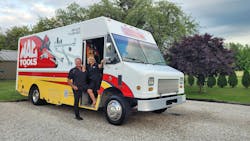Some of the most important tools in an automotive technician’s toolbox are their diagnostic test equipment. Unfortunately, these tools also tend to be the most technical. For distributors who started off as technicians and then got into the tool-selling business, diagnostic test equipment poses less of a problem. However, for those without that background, it can be difficult to know which tool is used for what and what tool will be best to help their customers get their repairs done quickly and efficiently. In this article, we’ll be looking at a few types of diagnostic test equipment – oscilloscopes, borescopes, and multimeters – and discussing what these tools do and how to get the right tool into the hands of your customers.
Mac Tools distributor Jim LaJoy is one of the lucky distributors with the inside scoop on some of these more complex tools. Before he began his journey as a mobile tool distributor five years ago, he worked as a technician for around 25 years. LaJoy notes that he was often on the road in the service van during the winter months and other “yucky” weather.
“The older I got,” he says, “I didn’t want to do it anymore.”
He and his wife, Nancy, decided it was time for a change. This decision happened to come at the perfect time, as LaJoy’s tool distributor was retiring, freeing up the Windsor, Ontario area for a new Mac Tools route.
LaJoy hits up a variety of stops in Windsor and Essex County including independent shops, dealerships, truck shops, and body shops. Regardless of the type of stop he’s at, he knows that when it comes to selling any sort of diagnostic test equipment you have to understand what the technicians are doing, what they’re currently using, and how it compares to what you have on your truck. To gain this knowledge, it’s best to start with the basics.
Know what you’re selling
With an inventory that covers everything from sunglasses to hammers to ADAS calibration equipment and more, distributors are expected to have a basic knowledge of a wide range of tools. Some are more simple and self-explanatory while others, such as the diagnostic test equipment we’re discussing, require a bit more research.
Oscilloscopes
Starting off with oscilloscopes, Randy Dillman, vehicle manufacturer account manager for Pico Technology, explains this tool is ideal for “providing diagnostic analysis for failures related to starting and changing, sensors, actuators, communications networks, engine mechanical performance, pressurized systems, NVH (noise, vibration, harshness) complaints, and much more.”
These tools are also known as lab scopes and are available as a stand-alone product, typically integrated with a scan tool or as a PC-based product.
Pico Technology’s oscilloscopes are PC-based, and their latest oscilloscopes, the PicoScope 4225A and 4425A, offer many features your customers may be interested in:
- A sampling rate of 400 MS/s and 12-bit (16-bit enhanced) resolution to provide clear, accurate waveform detail
- 20 MHz bandwidth to provide the capacity to test popular high-speed vehicle communications networks
- 250 M sample memory for long-duration captures helpful to diagnose intermittent faults
- PC connection via USB 3.0 to provide portable power and fast data transfer speeds
- Two or four floating input channels that allow safe, low-noise measurements even when none of the inputs are grounded
Dillman notes that one of the biggest benefits of using an oscilloscope is, “They remove the guesswork and unneeded parts changing that flow charts often lead to.”
Borescopes
Moving on to borescopes, ANSED Diagnostic Solutions’ National Sales Manager, Todd Haner explains that “Today’s borescopes allow a technician to inspect, record, and view components in restricted applications virtually eliminating the need to completely disassemble assemblies to view hidden objects or to inspect internal components.”
This tool can help save technicians time therefore increasing the shop’s profitability. Borescopes are also sometimes called inspection scopes or, depending on the tool’s capabilities, video scopes. Haner notes that borescopes with photo and video functionality can also provide a way for shops to share diagnostic procedures and findings with their customers.
ANSED’s latest borescope, the #DVSK39ART, offers a variety of features for technicians to utilize, including:
- A high-definition (HD) digital scope monitor coupled with a 3.9mm HD digital articulating probe to deliver image clarity and unlimited inspection possibilities
- The super flexible 3.9mm articulating probe is one of the smallest IP67-rated 360-degree articulating probes on the market
- The digital camera and adjustable LED lights are located at the end of the probe positioning these features in the work area
- A high resolution (1280 x 720) 3.5” full-view IPS LCD monitor screen provides exceptionally clear imagery and scope control functions.
- Other key features include an 8 G SD card to store photo and video recordings with date and time stamping, image rotation and digital zoom, and image brightness adjustment
A borescope can be used for a wide array of automotive applications, such as A/C and heater ductwork, blend doors, exhaust manifolds, pistons, valve systems, cylinder walls, and much more.
“Borescope applications are unlimited,” Haner says.
Multimeters
When it comes to multimeters, Dave Barden, senior manager of technical sales and training specialist for Power Probe, explains that because “…everything's become electronically controlled, the only way to diagnose those [components in a vehicle] is with the proper test equipment that can measure your voltages and your amperages and your resistances and those currents.”
Multimeters are the equipment necessary to run these tests.
“Anything that can give you a tangible measurement or reading is going to be more accurate than just an on-and-off indicator,” Barden says. “[Multimeters offer] greater accuracy, reliability, and repeatability.”
In Power Probe’s newest multimeter, the DM300 Auto, they are continuing to push its functionality beyond the typical multimeter functions like checking battery voltages or sensor resistance. A few of the tool’s features include:
- The meter is a CAT 3,000 voltmeter, meaning it's hybrid-safe and has all your multimeter functions, as well as things like starting system checks and charging system checks
- Offers extended range for reading current up to 30A directly
- Has the ability to read current across a fuse just by measuring across a fuse
Get the right tools in your customers’ hands
Oscilloscopes, borescopes, and multimeters are all necessary parts of a technician’s diagnostic test equipment line-up.
As Mac Tools distributor LaJoy sees it, “[The equipment] just helps [technicians] with their everyday job. It makes it easier with all this new technology. It’s like you can’t even change a set of windshield wiper blades on a car unless you have a scan tool.”
When you have tools like these that are more “needs” as opposed to “wants” for your customers, the only thing you really need to figure out is how to ensure you’re getting your customers the right tool for their needs.
Find the sales
Price plays a large role in people’s considerations when making a purchase. Anything you can do to help cut costs for your customers could aid in you making more sales. LaJoy notes that utilizing the sales featured in the flyers can be a way to encourage your customers to purchase some of those tools with higher price tags.
“With the way the economy's been the last few years,” LaJoy says, “everybody's kind of penny pinching a little bit…I find they wait till [the tool] comes out in the flyer to purchase it.”
Understand how the tool is being used
When trying to understand what tool to sell your customer, Pico Technology’s Dillman says this should be your first question,” What is the primary need and environment it will be used in?”
For example, due to PicoScopes being PC-based, he notes that a native Windows 10 or 11 computer is needed. The computer also needs to have sufficient processor speed and memory for users to effectively use the tool. It’s important to ensure the environment the tool will be used in fits the tool.
Similarly, Power Probe’s Barden notes you’ll want to be aware of what sort of work your customers are using the tool for. Some may need a top-of-the-line tool while others may be just as happy with a more inexpensive option, and some may want both.
“You don't wanna get [your customer] into something that's gonna be too overly complicated,” Barden says. “If he doesn't understand it, he can't use it, and he’s not gonna get results from it.”
Accessories are another factor to consider in how the tool is being used. For multimeters, your customers may need a different type or length of probe, alligator clip-ins, or a back probe adapter in order for the tool to best meet their needs.
The construction of the tool also makes a difference in what your customers may be interested in. ANSED Diagnostic Solutions' Haner points out that borescopes can have different-sized articulating probes each best for different applications. Factors such as probe quality and flexibility, screen size, and the ability to capture and transmit image/video files could all have varying importance from person to person.
Talk to the manufacturer
If you’re ever unsure about what a product does or how it can be used, Dillman recommends reaching out to the manufacturer to get a product overview. Another route you can go to get more information is reading the product’s user manual, notes Barden, or visiting the company’s website to find more details or potentially view a few informational videos.
Don’t make assumptions
Never assume that just because your customer already owns a piece of equipment that they’re happy with it or aren’t looking for an update or an accessory for it.
“Technicians want to know ‘what’s new’ when a distributor visits a shop,” Haner says. “Don’t wait for your customer to ask you, or your competition might beat you to the sale!”
Overall, when trying to help a customer get the best tool for them, LaJoy advises to just ask them what they’re looking for.
“I'm not really a pushy salesman,” LaJoy explains. “I'm just…trying to give them what they need, and I want the guys to be happy and satisfied with what they've purchased.”
About the Author
Emily Markham
Editor | PTEN and Professional Distributor
Emily Markham is the editor of Professional Tool & Equipment News (PTEN) and Professional Distributor magazines. She has been writing about the automotive aftermarket since 2019, after graduating from UW-La Crosse with a bachelor's degree in English. During her first three years with EndeavorB2B's Vehicle Service & Repair Group, Markham also wrote for Fleet Maintenance magazine.
Don't miss Markham's next article. Sign up for PTEN or Professional Distributor's weekly newsletter.

